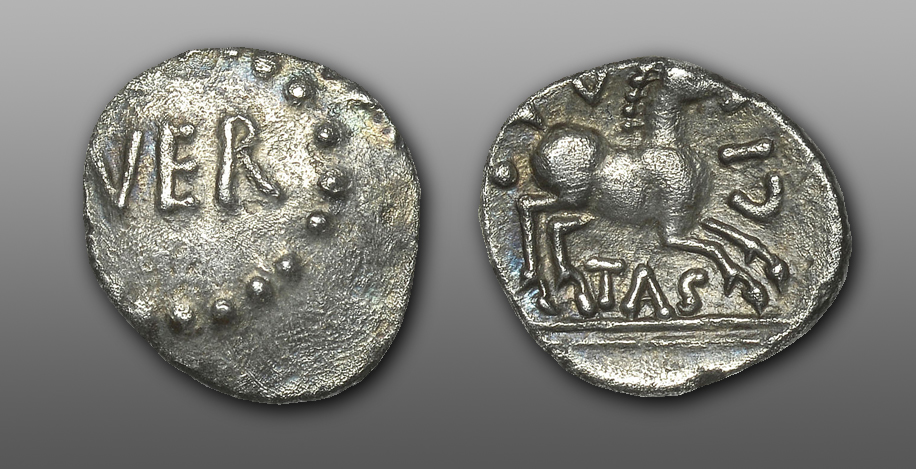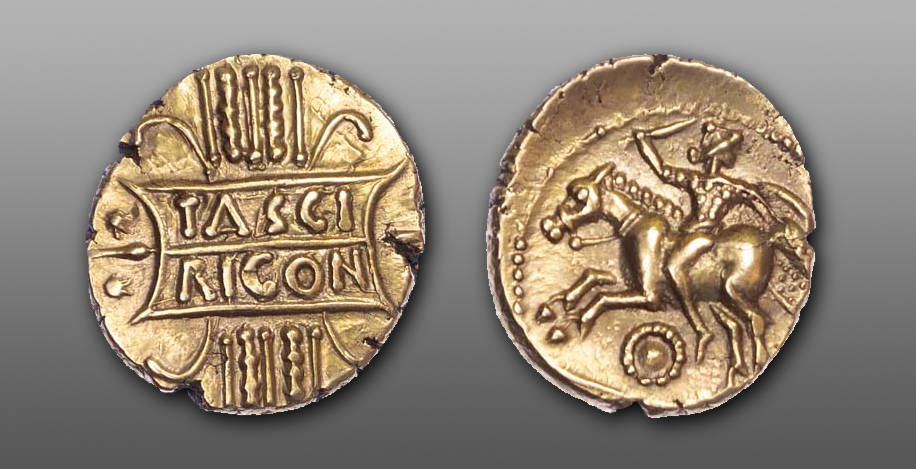Tasciovanus was the King of the Catuvellauni Celtic Tribe before the Roman conquest of Britain. Tasciovanus was the son of Addedomaros, whom he succeeded c.20 BC , and the father of Cunobelin and Epaticcus.

He was the first Catuvellaunian monarch to issue inscribed coins, bearing the Verulamium mint marks. He was also the first to renew hostilities towards the Trinovantes, flouting the long-standing agreement between Caesar and his own grandfather Cassivellaunus.
Between 10 and 15 BC he issued a series of coins bearing the mint mark Camulodunum, indicating that for a time at least, he took possession of the Trinovantian capital, but it appears that he withdrew following the advent of Augustus in Gaul.

His later coin issues bear the title rigon, usually translated as ‘king’. If this is the case, it is probable that Tasciovanus did not have a treaty with Rome, otherwise he would have used the Latin title Rex. A number of coins bear other names along with his own, for example TASC ¢¬¢ DIAS (Spink.267 & 269), TASCIO ¢¬¢ SEGO (Spink.259) and TAS ¢¬¢ ANDO (Spink.266); which may be indications of joint rule or deputisation, while coins bearing the lone names SEGO (Spink.260), ANDOCO (Spink.265) and RVES (Spink.273) also appear throughout the Catuvellaunian territories. The existence of these coin issues supports the suggestion that the Catuvellauni were originally a federation of like-minded Belgic tribes. Another alternative is that some, at least, of these names may be mint marks. He was succeeded by his brilliant son Cunobelin circa AD 10.
This British king is recorded on much inscribed coinage covering south-east England. His opposition to Rome is evident in the issue TASCIO RICON “Tascio[vanus] King” (Spink.219) which proudly uses the ancient word (Welsh/Gaelic) to denote his right to rulership. A large group of coins variously inscribed VERL TAS “Ver[u]l[amion] Tas[ciovanus]” (Spink.236, et al.) reveals his primary mint at Saint Albans, the ancient capital of his people. The famous issue bearing the legend TASCIOVAN ¢¬¢ CAM “Tasciovan[us at] Cam[ulodunon]” (Spink.216) proudly boasts of his acquisition of Colchester (Camulodunum), the capital town of the neighbouring Atrebates. Although none of his coinage shows clear indication of affiliation it is possible that the issues inscribed TASCI TASC and TASCIO TA SCI may be interpreted as “Tasciovanus [the son of] Tasci[ovanus?]” (Spink.223 & 250).
References for Tasciovanus Catuvellaunum
Coins of England and the United Kingdom – Spink Standard Catalogue of British Coins (Spink, London, 2002, 37th ed.); Celtic Coinage in Britain by Philip de Jersey (Shire, 1996).